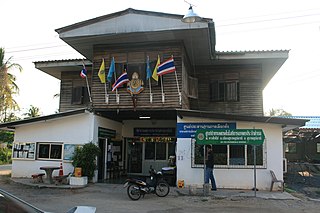
Samut Sakhon is one of the central provinces (changwat) of Thailand, established by the Act Establishing Changwat Samut Prakan, Changwat Nonthaburi, Changwat Samut Sakhon, and Changwat Nakhon Nayok, Buddhist Era 2489 (1946), which came into force on March 9, 1946.

Muban is the lowest administrative sub-division of Thailand. Usually translated as village and sometimes as hamlet, they are a subdivision of a tambon. As of 2008, there were 74,944 administrative muban in Thailand. As of the 1990 census, the average village consisted of 144 households or 746 persons.
Wang Prachan is a sub-district (tambon) of Khuan Don District, Satun Province of Thailand, at the boundary to Malaysia.
Wiang, Chiang Khong is a tambon (subdistrict) of Chiang Khong District, in Chiang Rai Province, Thailand. In 2005 it had a total population of 12,311 people. The tambon contains 14 villages.
Khrueng is a tambon (subdistrict) of Chiang Khong District, in Chiang Rai Province, Thailand. In 2005 it had a total population of 7,024 people. The tambon contains 11 villages.
Bun Rueang is a tambon (subdistrict) of Chiang Khong District, in Chiang Rai Province, Thailand. In 2005 it had a total population of 7,054 people. The tambon contains 10 villages.
Huai So is a tambon (subdistrict) of Chiang Khong District, in Chiang Rai Province, Thailand. The main settlement of the subdistrict is also named Huai So.
Si Don Chai is a tambon (subdistrict) of Chiang Khong District, in Chiang Rai Province, Thailand. In 2013, it had a total population of 8,813 people. The tambon contains 18 villages.
Wiang is a village and tambon (subdistrict) of Chiang Saen District, in Chiang Rai Province, Thailand. In 2005 it had a total population of 10,807 people. The tambon contains 10 villages. The Golden Triangle tri-point of Myanmar, Laos and Thailand is located in the village vicinity.
Ban Saeo is a village and tambon (subdistrict) of Chiang Saen District, in Chiang Rai Province, Thailand. In 2005 it had a total population of 11,444 people. The tambon contains 15 villages.

Si Don Mun is a village and tambon (subdistrict) of Chiang Saen District, in Chiang Rai Province, Thailand. In 2005 it had a total population of 8120 people. The tambon contains 14 villages.
Yonok is a village and tambon (subdistrict) of Chiang Saen District, in Chiang Rai Province, Thailand. In 2005 it had a total population of 4,777 people. The tambon contains 8 villages.
Nong Pa Ko is a village and tambon (sub-district) of Doi Luang District, in Chiang Rai Province, Thailand. In 2005 it had a population of 4,635 people. The tambon contains 10 villages.
Ta is a village and tambon (subdistrict) of Khun Tan District, in Chiang Rai Province, Thailand. In 2005 it had a total population of 13,091 people. The tambon contains 20 villages.
Tha Kham is a village and tambon (subdistrict) of Wiang Kaen District, in Chiang Rai Province, Thailand. In 2005 it had a total population of 5,425 people. The tambon contains 6 villages.

Ngao is a village and tambon (subdistrict) of Thoeng District, in Chiang Rai Province, Thailand. In 2005 it had a population of 9943 people. The tambon contains 20 villages.
Pa Sao is a village and tambon (sub-district) of Mueang Uttaradit District, in Uttaradit Province, Thailand. In 2005 it had a population of 7,478 people. The tambon contains eight villages.
Ban Dan Na Kham is a village and tambon (sub-district) of Mueang Uttaradit District, in Uttaradit Province, Thailand. In 2005 it had a population of 10,329 people. The tambon contains 11 villages.
Na In is a village and tambon (sub-district) of Phichai District, in Uttaradit Province, Thailand. In 2005 it had a population of 5751 people. The tambon contains seven villages.







